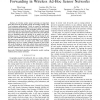Free Online Productivity Tools
i2Speak
i2Symbol
i2OCR
iTex2Img
iWeb2Print
iWeb2Shot
i2Type
iPdf2Split
iPdf2Merge
i2Bopomofo
i2Arabic
i2Style
i2Image
i2PDF
iLatex2Rtf
Sci2ools
INFOCOM
2008
IEEE
2008
IEEE
An Information Model for Geographic Greedy Forwarding in Wireless Ad-Hoc Sensor Networks
—In wireless ad-hoc sensor networks, an important issue often faced in geographic greedy forwarding routing is the “local minimum phenomenon” which is caused by deployment holes and blocks the forwarding process. In this paper, we provide a new information model for the geographic greedy forwarding routing that only forwards the packet within the so-called request zone. Under this new information model, the hole and its affected area are identified easily and quickly in an unsafe area with a labeling process. The greedy forwarding will be blocked if and only if a node inside the unsafe area is used. Due to the shape of the request zone, an unsafe area can be estimated as a rectangular region in the local view of unsafe nodes. With such estimate information, the new routing method proposed in this paper will avoid blocking by holes and achieve better performance in routing time while the cost of information construction is greatly reduced compared with the best results known to d...
Communications | Geographic Greedy Forwarding | Greedy Forwarding | Greedy Forwarding Routing | INFOCOM 2008 |
| Added | 31 May 2010 |
| Updated | 31 May 2010 |
| Type | Conference |
| Year | 2008 |
| Where | INFOCOM |
| Authors | Zhen Jiang, Junchao Ma, Wei Lou, Jie Wu |
Comments (0)

